
Tutorial 2
How do you determine a patient's blood type?
You need to know the patient’s blood type in order to make safe blood transfusions. Primarily you try to give the same blood type in a blood transfusion as the patient has got.
From Tutorial 1 you know that the blood type notation indicates what antigens there are on the surface of the red blood cells. So, to determine blood type, you need to find out which antigens are present. You can work that out by mixing the patient’s blood with three different reagents containing either of the three antibodies: A, B or Rh.
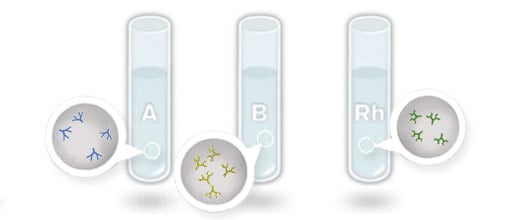
Test tubes containing three different reagents with either A, B or Rh antibodies. The antibodies attach to antigens on the patient's red blood cells if they match.
Blood typing procedure:
1. Mix!
First mix the patient's blood with three different reagents including either of the three different antibodies, A, B or Rh antibodies!
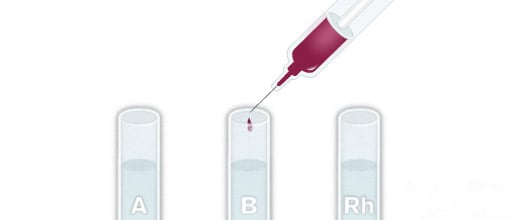
2. Look for agglutination!
Then you take a look at what has happened. In which mixtures has clumping, or agglutination, occurred? The agglutination indicates that the blood has reacted with a certain antibody and is therefore not compatible with blood containing that kind of antibody. If the blood does not agglutinate, it indicates that the blood does not have the antigens binding the special antibody in the reagent.
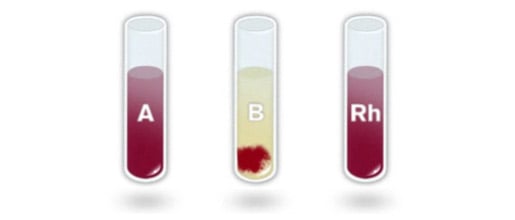
3. Figure out the ABO blood group!
Start by taking a look at the test tubes containing A and B antibodies. Has the blood agglutinated in either of these two tubes?
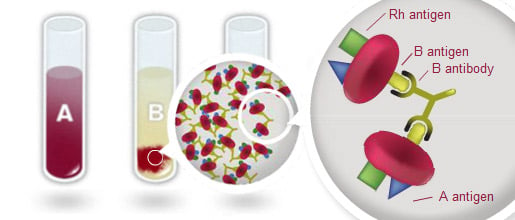
No agglutination in test tube A, indicates that the patient's red blood cells do not have A antigens.
Agglutination in the tube containing B antibodies indicates that the patients' red blood cells have got B antigens, thus belongs to blood group B.
4. Figure out the Rh blood group!
Now have a look at the test tube containing Rh antibodies!
Has the blood agglutinated or not?
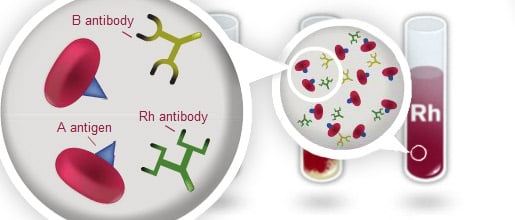
No agglutination indicates that the patient's red blood cells don't have Rh antigens, thus the blood is Rh-.
5. Figure out the blood type!
Now that you know which antigens are in the patient's blood, you can figure out the blood type!
Since agglutination only occured in the test tube containing B antibodies, the blood got B antigens but no A or Rh antigens. Thus the blood type is B Rh- .
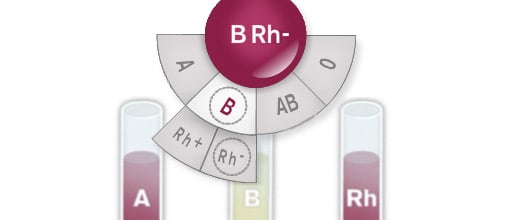
Test yourself!
Can you determine the blood type?
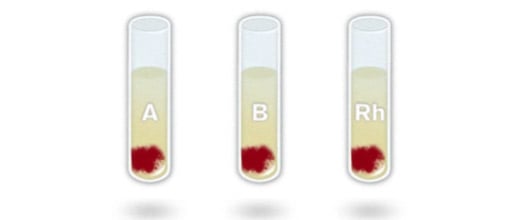
Agglutination in all three test tubes indicates that all three antigens are present in the blood: A, B and Rh. Accordingly, the blood type is AB Rh+.
Can you determine the blood type?
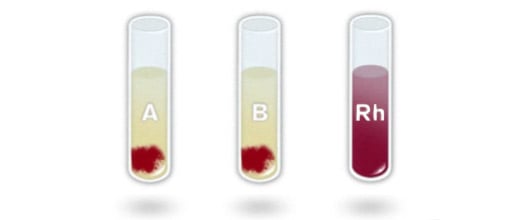
Agglutination in the test tubes containg A antibodies and B antibodies. Accordingly, the blood type is AB Rh-.
Can you determine the blood type?

Agglutination in the test tube with Rh antibodies
indicates that the blood has got Rh antigens but no A nor B antigens.
The blood type is O Rh+.
What has happened when the blood agglutinates?
The blood will agglutinate if the antigens in the patient's blood match the antibodies in the test tube. A antibodies attach to A antigens - they match like a lock and key - and thus form a clump of red blood cells. In the same way B antibodies attach to B antigens and Rh antibodies to Rh antigens. In the test tubes where agglutination has occured, the patient's red blood cells have been linked together, like bunches of grapes, instead of floating around one by one .
Disclaimer:
The fact that people with Rh- blood do not naturally have Rh antibodies in the blood plasma (as one can have A or B antibodies, for instance) is not taken into consideration in this game. In reality a person with Rh- blood can develop Rh antibodies in the blood plasma if he or she receives blood from a person with Rh+ blood. The received blood cells with Rh antigens can trigger the production of Rh antibodies in an individual with Rh- blood. In the game one has to pretend that all patients with Rh- blood type has received Rh+ blood in previous blood transfusions.
Also, the antibodies are here referred to as A antibodies, B antibodies and Rh antibodies. These are also commonly referred to as anti A antibodies, anti B antibodies, and anti Rh antibodies.